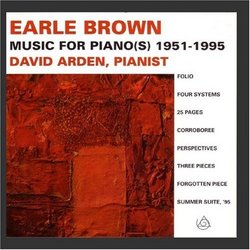Open Forms,Systems/Mobility, Graphics,Timbres
scarecrow | Chicago, Illinois United States | 11/26/2002
(5 out of 5 stars)
"The passing of Earle Brown this last July, 2002 was indeed a loss to American experimentalism. Brown is known for his early ongoing associations with John Cage, a card carrying memeber of the Cage School. He recalls he first had met Cage in Denver in 1951 and had revealed his newly written "Three Pieces".The astonished Cage said "send this to me in New York", and David Tudor proceeded to perform it. In fact most of the experimentalions in musical graphics, indeterminacy would be unthinkable without the pianistic interpretations of David Tudor.It's possible to divide Brown's creativity into three periods, the early, the Fifties, where this disk concentrates,the Sixties which sees the coagulations, concretizations of Brown's theories of open form,mobile form and musical graphics. The impressive String Quartet from this period is a high point, and here we get on this disk Corroboree (1964), for three pianos. David Arden pre-records the other pianos. This is a work which does suggest its marginal programmatic image of the noisy Australian aboriginal festival,with obviouslike rhythms emerging but within the context of the opaque musical moments,musical space is redivided here into beautiful like moments of an entire array of sounds and indeed plumbs the depths of piano timbre, with fascinating muting of strings, finger plucking,hand and forearm clusters,key muting, and harmonics. The work for its antiphonal interest should be heard live, so hear you need to imagine these piano separations emanating from differnent places.
All of the Folio is here largely a work constructed around musical graphics. Within the Cage School, Brown creatively was in the center, not revealing excessive indulgences in musical graphics as Cage himself as in his 'Concert for Piano',which is/was a virtual encyclopedia of what is possible in music performing and graphics,vertical, horizontal, procedures, processes, following circles around, nor was Brown not so much aesthetic bound to his musical objects as Feldman,or Christian Wolff where timbral placements,register, and instrumentation was indeed important than process. Brown's affinity coming from his early studies in engineering and the theories of Jospeh Schillinger informed him very differently than Cage and his interface with Zen thinking,or Feldman's engagements in the painterly world of tone, shape, density,layerings,concept.Brown I think limits himself to the mobiles of Alexander Calder for instance. Improvisation was not an objective here for any memeber of the Cage School.
Most of the creativity here as well resides in the skills of the performer,which does require one to have travelled the oceanic performative seas of improvisation to impart this lifeworld into the cold;y abstract musical graphics and David Arden is an extraordinary interpreter. He is not quite as adventuresome,pushing conceptual envelopes as David Tudor, Arden runs a middle course in his approach to the open-ness of timbre, of placement of gesture, all which resides in the performer in the freedom that musical graphics allows. Here you have as in 4 Systems simply black horizontal bars placed like in perpsective on the page(one page), a page that can be read left to right right to left, or turned upsidedown for a reading also no dynamics or articulations are indicated,registral placement is somewhat suggested,so the performer must decide these elements.
Perspectives from 1952 is completly written,and we see another side to Brown,like giving away creative clues, on the aesthetic interests of the creator, for this work has a violent pointillism that was in the post-war air in the Fifties,it may remind you of a timid Boulez Second Sonata. I beleive through these opaque, indeterminate/determinate musical grpahics we can discern where Earle Brown philosphic aesthetic resides, and I think his music does have an understated quality to it, a gentleness,sparce,thinly threadbare,poetic as can be and evocative at times, even though his aim was not to create a discernable discreet aesthetic object.
The latter Summer Suite from 1995 certainly proclaims this we see a Brown perhaps with the accessibility bug had bit him as everyone,the force fields of postmodernity in place. This is a work far more lyrical within the Brown context, of what represents lyrical moments. In the notes Brown says himself that this work is "jazzy" but I didn't see that, and if it was it would not be interesting jazz."


 Track Listings (28) - Disc #1
Track Listings (28) - Disc #1